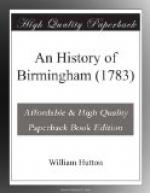The authors I have seen are all in the wrong; and as my researches are confined, it is a mortification, I am not able to set them right. They have confounded the two classes together, which were very distinct in chronology, the manner of making, and their use. If an author treats of one old road, he supposes himself bound to treat of all in the kingdom, a task no man can execute: by undertaking much, we do nothing well; the journey of an antiquarian mould never be rapid. If fortune offers a small discovery, let him think, and compare. Neither will they ever be set right, but continue to build a mouldering fabric, with untempered mortar, till a number of intelligent residents, by local enquiries can produce solid materials for a lasting monument.
The Romans properly termed their ways streets, a name retained by many of them to this day; one of the smaller roads, issuing from London, penetrates through Stratford upon Avon (Street-ford) Monks-path-street, and Shirley-street, to Birmingham, which proves it of great antiquity, and the Ikenield-street running by it, proves it of greater. We may from hence safely conclude, Birmingham was a place of note in the time of Caesar, because she merited legislative regard in forming their roads; which will send us far back among the Britons, to find her first existence.
Though we are certain the Ikenield-street passes about a mile in length through this parish, as described above; yet, as there are no Roman traces to be seen, I must take the curious traveller to that vast waste, called Sutton-Coldfield, about four miles distant, where he will, in the same road, find the footsteps of those great mailers of the world, marked in lasting characters.
He will plainly see its straight line pass over the Ridgeway, through Sutton Park, leaving the West hedge about 200 yards to the left; through the remainder of the Coldfield, till lost in cultivation.
This track is more than three miles in length, and is no where else visible in these parts. I must apprize him that its highest beauty is only discovered by an horizontal sun in the winter months.
I first saw it in 1762, relieved by the transverse rays, in a clear evening in November; I had a perfect view upon the Ridgeway, near King’s-standing of this delightful scene: Had I been attacked by the chill blasts of winter, upon this bleak mountain, the sensation would have been lost in the transport. The eye, at one view, takes in more than two miles. Struck with astonishment, I thought it the grandest sight I had ever beheld; and was amazed, so noble a monument of antiquity should be so little regarded.
The poets have long contended for the line of beauty—they may find it here. I was fixed as by enchantment till the sun dropt, my prospect with it, and I left the place with regret.
If the industrious traveller chooses to wade up to the middle in gorse, as I did, he may find a roughish journey along this famous military way.




